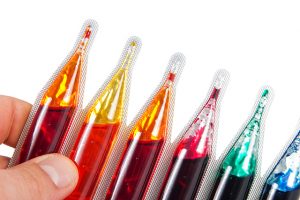
Cochineal Extract — toxicity, side effects, diseases and environmental impacts
Friday, December 08, 2017 by Rita Winters
http://www.naturalpedia.com/cochineal-extract-toxicity-side-effects-diseases-and-environmental-impacts.html

Cochineal extract, also known as Carmine and Brilliant Scarlet, is a dye extracted from the female Costa cochineal insect (Dactylopius coccus). This dye was used by the Aztecs long before Europeans discovered it in the 1500s, as a fabric coloring material that remained vibrant for a long time. Today, cochineal bugs are harvested in prickly pear plantations in Peru and the Canary Islands. To make the dye, the bugs are sun-dried, crushed, and then mixed in an acidic solution to produce carminic acid, which then becomes cochineal extract. Approximately 70,000 cochineal insects are needed to produce one pound of the dye. This dye can produce a variety of shades such as pink, red, crimson, and purple. Aside from its main purpose of food coloring, cochineal extract is also used in cosmetic products and in some medical pill coatings. Other names of cochineal extract include Ponceau 4R, Cochineal Red A, New Coccine, and SX Purple.
Since 2009, the Food and Drug Administration (FDA) has required producers to specify products that contain cochineal extract since it causes or provokes severe allergic reactions in some individuals. The European Union requires food containing this colorant to include in the label “may have an adverse effect on activity in children”, after studies reported that hyperactivity in children may be caused by such.

List of known side effects
A number of studies show that cochineal extract may cause severe allergic reactions in some individuals. The negative side effects include diarrhea, anaphylaxis (life-threatening allergic reaction), asthma, and hives. It is also known to cause hyperactivity in children.
A 30-year old man used carmine in chorizo for three months when he developed asthma. Upon hospitalization, tests revealed that he had eosinophilia, an increased number of disease-fighting white blood cells, and an elevated serum immunoglobulin (Ig) E concentration (which also fights diseases). He was found to have developed severe bronchospasm. The asthma recurred upon resuming work, and ceased when he discontinued.
One hour after drinking a Campari, a 28-year old woman developed a disorder of the larynx. From there, she continued to reactions such as edema of the eyelids and irritation, followed by generalized urticaria (skin rash), intense stomach ache, and diarrhea. The same symptoms occurred on three other occasions while consuming strawberry-flavored milk or red-colored cocktails. She underwent skin prick allergy tests that showed a positive allergic reaction to cochineal extract, which all the food items had.
An anaphylactic reaction was reported from a 34-year old atopic woman after drinking Campari with orange juice. She experienced sneezing, rhinitis and conjunctivitis, pruritus (skin itch), urticaria, Quincke’s edema (skin swelling), dyspnea, bronchospasm, chills, nausea, vomiting, and diarrhea. Cochineal extract allergy was singled out among all other previously ingested foods. She also had experienced allergic reactions to other food items that didn’t have cochineal extract declared on their label.
Known side effects are based primarily on case reports. No in-depth nor extensive tests have been performed since.
Body systems affected by cochineal extract
Cochineal extract may result in severe problems in the dermis and respiratory system.
Items that can contain cochineal extract
Cochineal extract is used to color many food items such as yogurt, candy, beverages, applesauce, baked goods, red-colored foods, and other strawberry- or cherry-flavored foods.
How to avoid cochineal extract
The FDA required manufacturers to indicate if their product contains dyes from natural sources, including cochineal extract. Always search the label for any mention of food coloring, cochineal extract, or any of the other alternate names as mentioned above. Avoid eating highly processed foods that contain different colors, especially those that don’t come with a label (street-sold ice cream).
Where to learn more
- Vegetarians beware: Starbucks admits to using beetle extract in popular drink coloring
- Dietitian singles out ground-up insects in red velvet cupcakes as the cause for growing food allergies
- Our Favorite Junk Foods are Changing
- Junk Foods are now called Snack Foods
- Ten horrifying ingredients that prove McDonald’s is not fit for consumption
Summary
Cochineal extract is a dye for food, fabrics, and other items.
There are only a few people with allergies to cochineal extract, but precaution must still be taken by other, non-allergic people.
The many cases of cochineal extract allergic reactions involved anaphylactic shock and almost resulted in fatality.
Cochineal extract may be fatal in large amounts.
Sources include:
Tagged Under: Tags: cochineal extract





